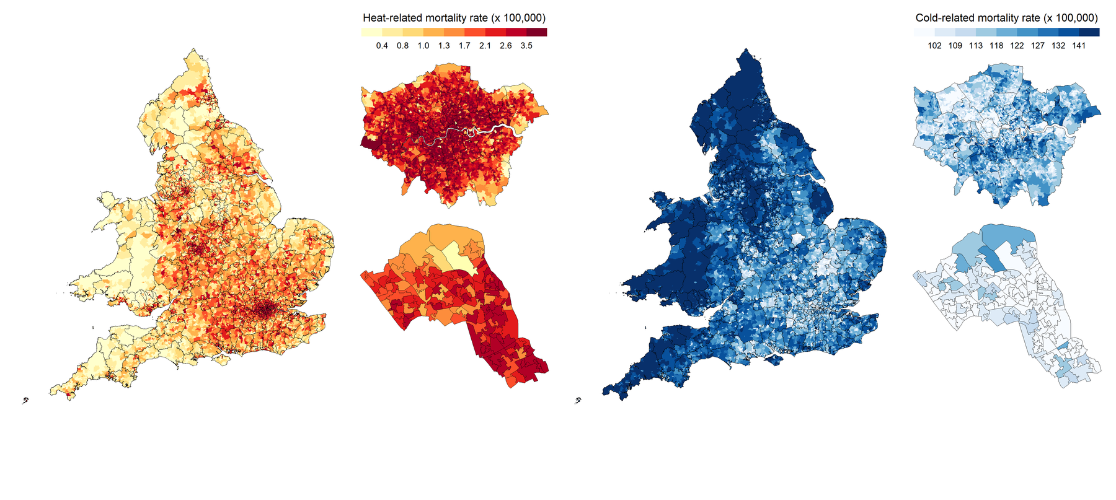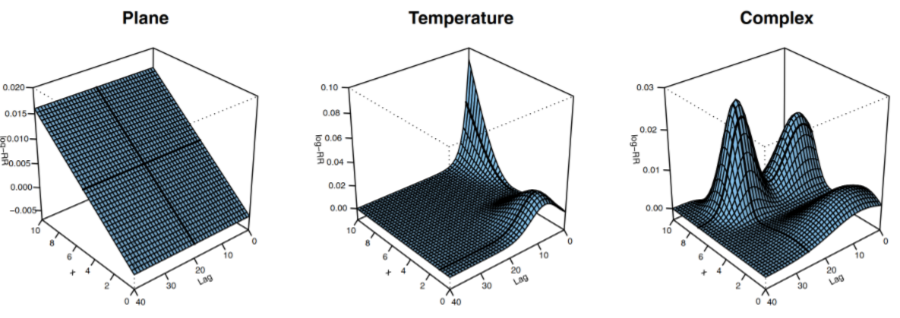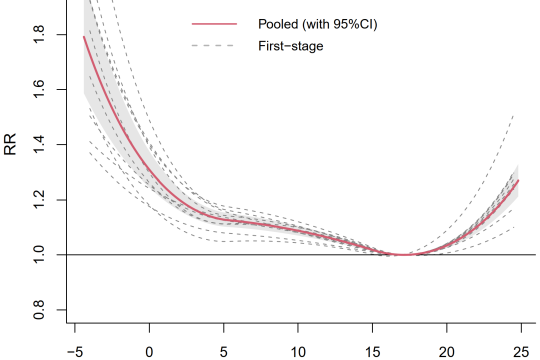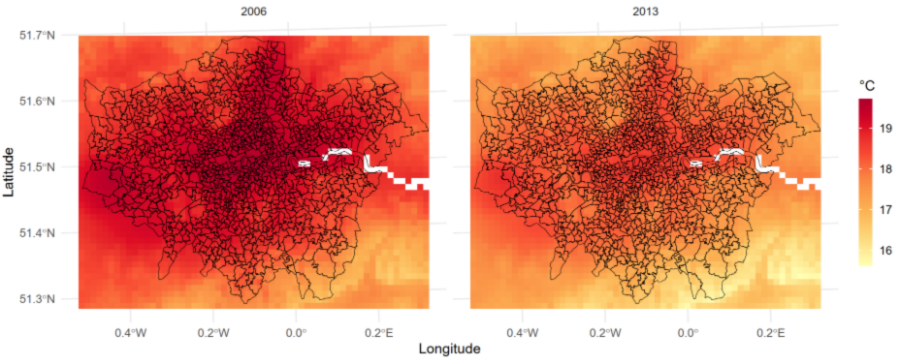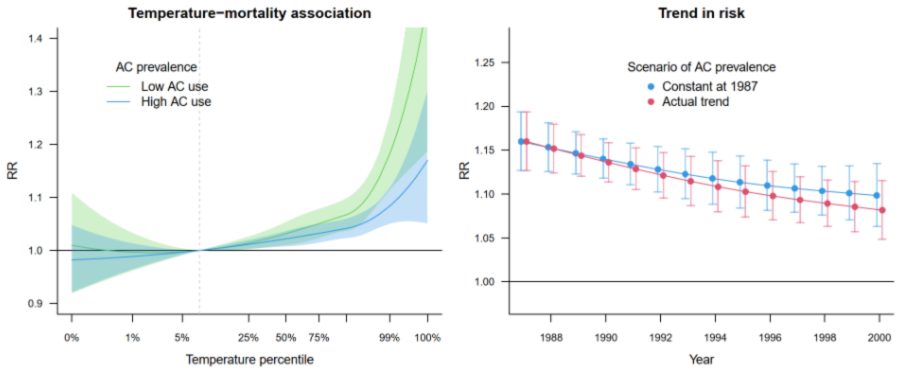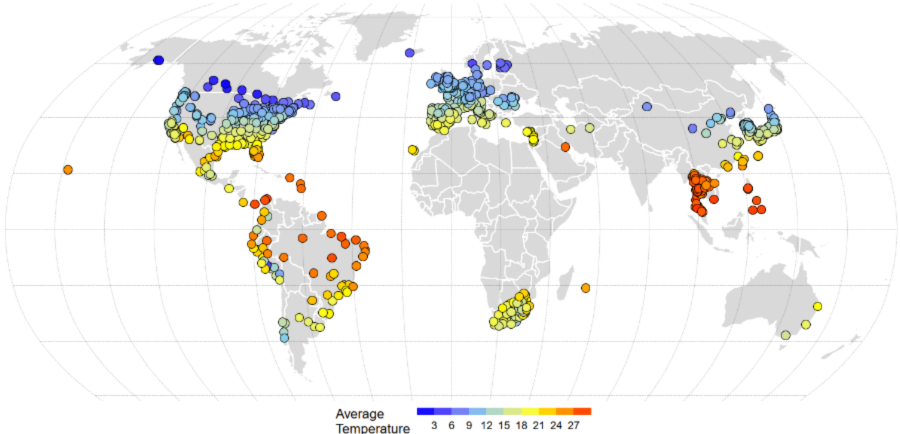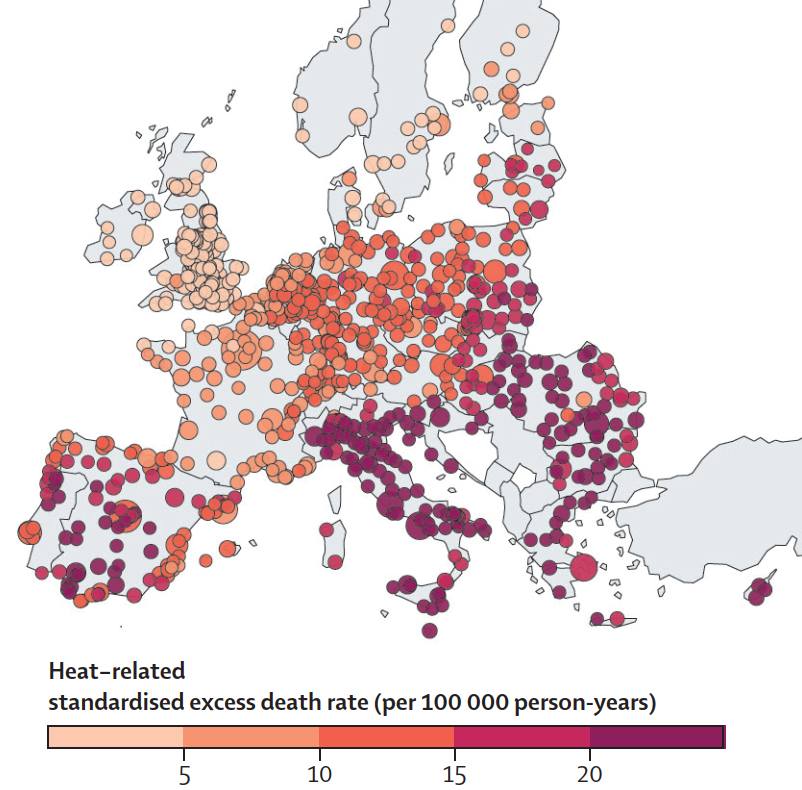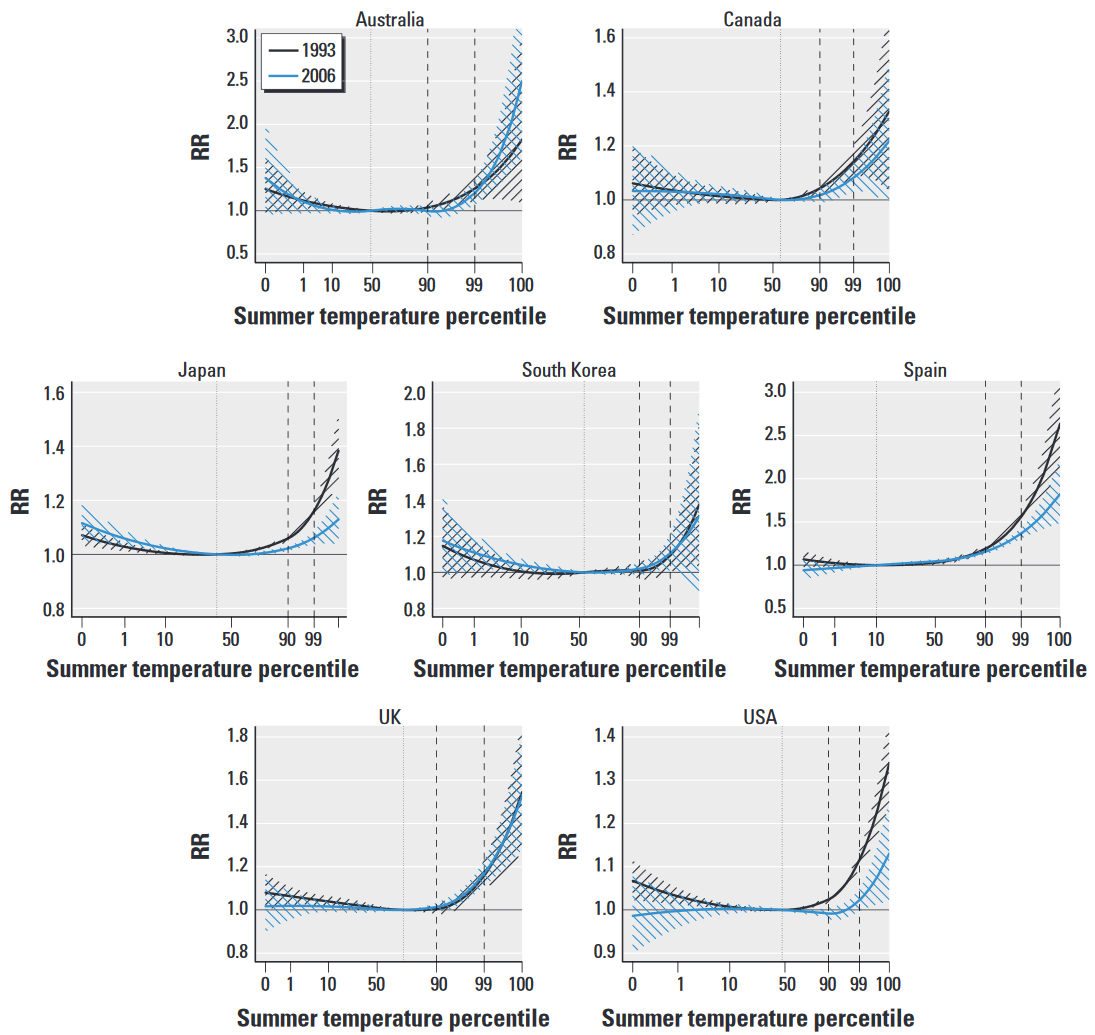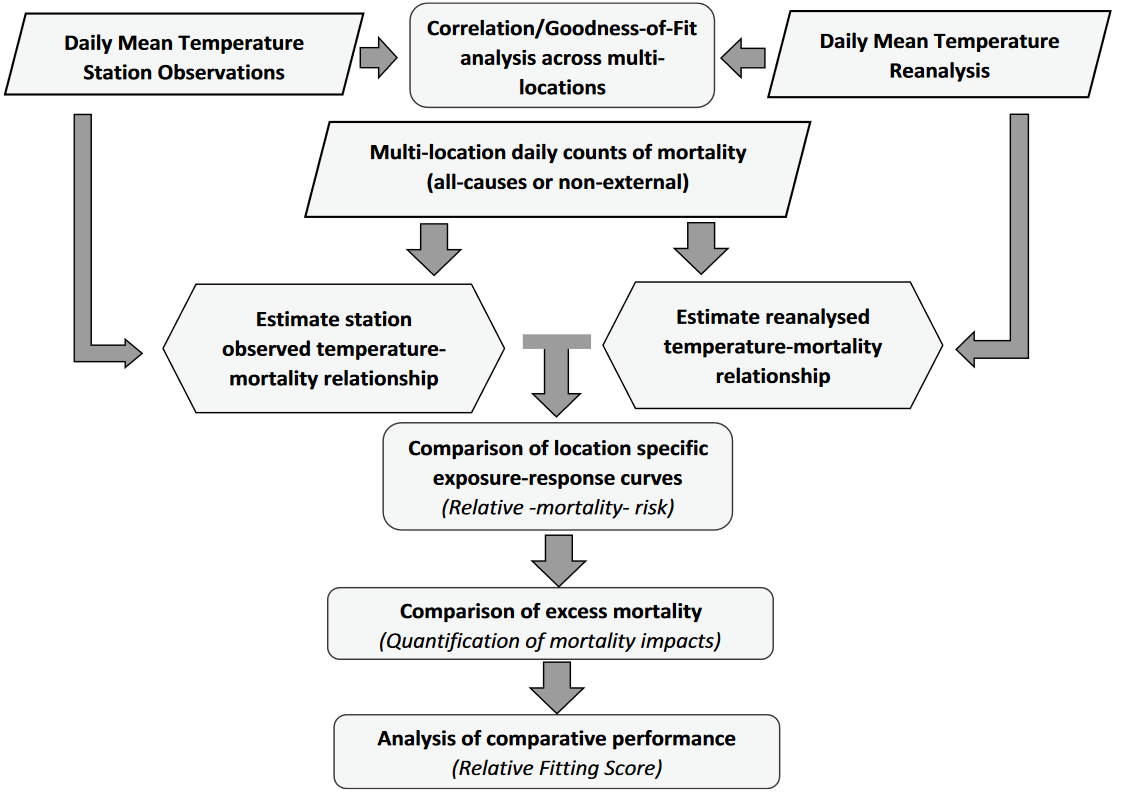Our mission is to develop innovative epidemiological methods to study the impact of environmental stressors on human health.
We are a research team with complementary expertise in biostatistics, epidemiology, data science and climatology, based at the London School of Hygiene & Tropical Medicine.
The Environment and Health Modelling Lab is a team of researchers based in the Department of Public Health, Environments and Society at the London School of Hygiene & Tropical Medicine. We have multi-disciplinary expertise spanning biostatistics, environmental epidemiology, data science, statistical computing and climatology.
Our research aims to improve understanding of how environmental factors affect human health. Our work has a strong methodological focus and has contributed to the development of new study designs, statistical methods and modelling techniques for epidemiological analyses. We are exploring and pioneering the use of biostatistical tools and modern computing and data technologies to advance research in these fields.
Our research outputs cover a wide range of areas, including epidemiological studies on health risks associated with non-optimal temperature and air pollution, spatio-temporal modelling and environmental exposures, health impact projections under climate change scenarios and the use of new data technologies for environmental health studies.
Grace O'Brien
Project Coordinator
Our research covers a wide range of topics, including: methodologies, global health modelling, climate change and health, air pollution, and spatio-temporal modelling.
Focus areas:
-
Statistical Methodologies
-
Distributed lag linear and non-linear models
Distributed lag models (DLMs) represent an elegant methodology for describing lagged association in time series data. Originally developed in econometrics, they are now frequently used in epidemiological analysis. Pioneering work by Ben Armstrong extended them to distributed lag non-linear models (DLNMs) for non-linear temperature-mortality relationships.
We proposed a unified statistical framework for the DLM/DLNM class, based on the definition of a cross-basis, a bi-dimensional space of functions that describes the association simultaneously along the space of predictor and lag. Later, we generalised the methodology beyond time series data, allowing applications in various epidemiological fields. Finally, we extended their statistical definition to penalised DLNM, implemented through generalised additive models (GAM). Other specific extensions implemented first the reduction of DLNMs to uni-dimensional summaries, useful to combine results from multi-location analyses, and then the computation of attributable risk measures. The framework has been formally assessed in a simulation study to model lagged associations in environmental time series data. The DLM/DLNM methodology is implemented in the R package dlnm.
An extended meta-analytical framework
Standard methods for meta-analysis are limited to pooling associations represented by a single effect size estimated from a set of independent studies. However, this setting can be too restrictive for modern meta-analytical applications.
The EHM-Lab has first contributed to developing multivariate meta-analytical methods for pooling multiparameter estimates representing complex associations. We then developed a general framework for meta-analysis based on linear mixed-effects models that includes, as special cases, multivariate, network, multilevel, dose-response, and longitudinal meta-analysis and meta-regression. Applications of these meta-analytical developments have been described in a tutorial on extended two-stage designs for environmental epidemiology. The methodology has been implemented in the R packages mvmeta and mixmeta.
- Study Designs
-
The case time series design
Modern linkage methods and data technologies provide a way to reconstruct detailed longitudinal profiles of health outcomes and predictors. This rich data setting, however, poses important methodological and computational problems that traditional epidemiological methods are not well suited to address.
Research by the EHM-Lab has led to the development of the case time series (CTS) design, a novel methodology that combines the longitudinal structure typical of aggregated time series with the individual-level self-matched methods. The modelling framework is highly adaptable to various outcome and exposure definitions, and it is based on efficient methods that make it suitable for the analysis of highly informative longitudinal data resources.
The main article introduced the CTS design and illustrated applications in case studies using environmental and clinical data. A following tutorial article adapted the CTS methodology for the analysis of small-area data. The statistical framework is based on conditional regression models, presented in a methodological article.
Small-area analysis of environmental risks
The increased availability of data on health outcomes and risk factors collected at fine geographical resolution makes possible conducting small-area epidemiological studies. However, this setting poses important methodological and computational issues, related to modelling complexities and data linkage.
The EHM-Lab has developed cutting-edge study designs for the analysis of small-area data. These methods allow the use of finely disaggregated health data linked with high-resolution environmental exposure measurements through GIS techniques. The framework offers the opportunity to study local variations in risk and the role of area-level characteristics in modifying the vulnerability to environmental stressors. We provided a methodological description of the design in a tutorial article, and an application to study small-area temperature-related risks.
Extensions of two-stage designs
The two-stage design has become a standard tool in environmental epidemiology to model multi-location data. The EHM-Lab has recently proposed multiple design extensions of the classical two-stage design structure, all implemented within a unified analytical framework based on linear mixed-effects models.
The extended two-stage methodology, described in a recent tutorial article, permits the analysis of associations characterised by combinations of multivariate outcomes, hierarchical geographical structures, repeated measures, and/or longitudinal settings. We have applied it in various epidemiological analyses, including for quantifying mortality impacts of heat and cold, investigating air pollution effects clustered at multiple geographical levels, assessing differential risks by age and geographical areas, quantifying excess mortality during the COVID-19 outbreak, and estimating the role of air conditioning in attenuating heat-related mortality.
Interrupted time series design
Interrupted time series (ITS) analysis is a valuable study design for evaluating the public health interventions. Its quasi-experimental nature allows quantifying effects of policies or events using a pre-post comparison while controlling for temporal trends.
We first illustrated the application of the ITS method for epidemiological analysis in a tutorial article that discussed design features and assumptions. Specific methodological contributions focused instead on model selection and the use of controls. The EHM-Lab has contributed to several applications of the ITS design, for instance for assessing the association between smoking bans and cardiovascular risk, the effect of the financial crisis on suicides, the impact of media coverage on the use of statins, the relationship between self-defence laws on firearm-related homicides, the effect of taxation on the sales of sugar-sweetened beverages, the impact of healthcare reforms on hospital care, and the excess mortality during the COVID-19 outbreak.
- The MCC Study
-
The EHM-Lab coordinates the Multi-Country Multi-City (MCC) Collaborative Research Network, an international collaboration of research teams aiming to produce epidemiological evidence on associations between environmental stressors, climate, and health. The research program benefits from the use of the largest dataset ever assembled for this purpose, including information on environmental exposures, health outcomes, and climate projections from hundreds of locations within several countries around the world.
Through MCC, we have led epidemiological analyses in several research areas. Initial studies focused on temperature-related risks, with the quantification of health impacts of heat and cold, the analysis of long-term and seasonal variation in risks, the role of humidity and inter/intra-day variability, long-term effects, and the minimum-risk temperature. Further studies first projected the mortality burden under future scenarios and for global temperature thresholds, and then quantified the impact of climate change in the historical period. More recent investigations assessed short-term risks of air pollutants in the largest multi-country analyses ever published, including studies on particulate matter (PM10 and PM2.5, as well as PM2.5-10), ozone (O3), nitrogen dioxide (NO2), sulphur dioxide (SO2), and carbon monoxide (CO), in addition to the analysis of risks by pollution components. The MCC Network has also contributed research on COVID-19, specifically about the role of methodological factors on the SARS-CoV-2 transmission.
- Climate and health
-
Temperature and mortality
Non-optimal outdoor temperature is one of the leading causes of health burden attributed to environmental factors, with both heat and cold associated with substantial impacts on mortality and morbidity. The EHM-Lab has led this research topic by developing state-of-the-art statistical framework and study designs, and then applying them in substantive studies.
A seminal article by the EHM-Lab first presented a multi-country analysis of excess mortality due to heat and cold, while other contributions assessed long-term effects of temperature and related risks for cause-specific mortality. The modelling framework has been extended in recent years, as illustrated in a more recent analysis of 854 urban areas across Europe, and in a small-area study of temperature-related risks. Parallel work has focused on the study of the optimal temperature across populations, first with a methodological contribution and then with a global analysis on the minimum mortality temperature (MMT). Another analysis evaluated the use of excess winter deaths as an impact measure for public health.
Analysis of vulnerability and adaptation factors
Health impacts of environmental and climate stressors vary dramatically both geographically and temporally, due to changes in vulnerability within and between populations. The issue is of primary interest for the definition of public health policies, in particular for identifying effective adaptation pathways to reduce the impact of climate change.
The EHM-Lab has provided several contributions to characterise differential vulnerability to heat and cold and to study potential adaptation strategies. We first assessed long-term variations in mortality and then acclimatation processes leading to changes in risks within a season. We then investigated adaptive mechanisms related to heat and cold in a changing climate. Furthermore, we evaluated vulnerability factors responsible for differential risks of heat and cold, and the specifically assessed the role of air conditioning in decreasing heat impacts. We also linked large scale climatic teleconnections to annual variations in heat-related deaths. Finally, we explored ways to determine real-time health impacts for national heatwave plans.
Health impact projections of climate change
Climate change is the defining global issue of our time. A critical step in climate change research is to project impacts under different scenarios of greenhouse gas emissions, which should in turn inform alternative adaptation and mitigation policies. The EHM-Lab has contributed substantially to this topic.
We first developed a modelling framework for health impact projections, illustrated in a tutorial article that described the various steps and methodologies. We then applied such framework in applied studies to quantify the excess mortality due to heat and cold, both under various emission scenarios along the 21st century and then for global mean temperature thresholds. A more recent study assessed the contribution of anthropogenic emissions to heat-related excess mortality in the historical period.
Assessment of weather-related risks
The assessment of climate-related health impacts requires the analysis of various weather indices. In addition to daily measures of dry-bulb temperature, the scientific literature includes studies on various indicators, which can inform both the definition of specific physiological pathways and the better characterisation of susceptibility profiles.
The EHM-Lab has led various epidemiological analyses on various weather indices, including assessment on the role of humidity in enhancing mortality risks, associations with alternative measures such as inter/intra-day variability, and composite indicators such as the universal thermal climate index (UTCI). Another important contribution was the assessment of climate reanalysis data for performing epidemiological studies on temperature-related risks.
- Air pollution
-
Further details coming soon
- Spatio-temporal modelling
-
Further details coming soon
[Dataset] Temperature-related mortality exposure-response functions for 854 cities in Europe
This repository provides exposure-response functions by five age groups for most cities with more than 50,000 inhabitants in Europe. It includes coefficients and variance-covariance of B-spline bases to reconstruct the curves, simulations to represent uncertainty as well as city-specific temperature percentile.
Access the dataset on Zenodo
Read the publication
Further resources
We provide the code for our analysis so our work can be applied elsewhere. Visit the links below:
The EHM-Lab is looking for a highly motivated research assistant to conduct environmental epidemiology analyses using novel epidemiological methods. The role will focus on analyses for the Constrained estimation project, although the successful candidate will also have the opportunity to be involved in other projects from the EHM Lab members. The successful candidate should be willing to familiarise themselves with the state-of-the-art methods in environmental epidemiology and engage in rigorous scientific practice.
Read the full job description and apply here. Closing date for applications is Tuesday 25 June 2024.
Extreme weather and global pandemics are both leading health concerns, however they are often studied as separate crises. This study, published in Nature Communications, is the first to quantify the health impacts of the co-occurrences of these crises, by estimating the mortality attributable to extreme heat and cold events during the COVID-19 pandemic in England and Wales during 2020-2022. The research, co-authored by Professor Antonio Gasparrini from the EHM-Lab at LSHTM, revealed that temperature-related mortality exceeded COVID-19 mortality by 8% in South West England, and the combination of extreme temperatures and COVID-19 led to excess deaths during heatwaves and cold snaps that were at least 2 times higher than the previous decade. The complex interactions at the intersection of extreme weather events and pandemics can result in major societal risks by overwhelming health systems, and anticipating and preparing for the co-occurrence of extreme weather events and major disease outbreaks, alongside the implementation of effective climate adaptation and mitigation strategies are crucial steps to improve population resilience and reduce the impacts of climate change.
Research on the relationship between stroke mortality and extreme temperatures has previously been limited to mostly high income single cities or countries, and presented conflicting results. A recent study led by Harvard University and co-authored by Professor Antonio Gasparrini from the EHM-Lab at LSHTM, used the Multi-Country Multi-City (MCC) Network to build a new mortality database for ischemic and hemorraghic stroke between 1979 and 2019, across 522 cities in 25 countries. The analysis, published in Stroke, found that 9.1 in 1,000 ischemic or hemorrhagic stroke deaths were attributable to extreme cold temperatures, and 2.2 in 1,000 to extreme heat. The study also revealed that low-income countries bore a higher burden of heat-related hemorrhagic stroke mortality than high-income countries, which could be due to better indoor temperature control systems and lower rates of outdoor work in high-income countries, in addition to lower-quality health care in low-income countries. The authors call for professional stroke societies and governments to invest more into climate-related stroke research and the interventional strategies needed to mitigate impacts on stroke mortality, which is already a significant cause of mortality worldwide.
Read the press release by Harvard University, and the full publication.
This article, co-authored by Professor Antonio Gasparrini from the EHM-Lab at LSHTM provides a review of the health risks associated with heat exposure as a result of human-induced climate change, and explores some of the epidemiological data linking heat and health outcomes. The study, published in The New England Journal of Medicine, highlights populations at a particularly high risk for heat-related illnesses, mentioning disparities between different race or ethnic groups and socioeconomic statuses. The authors discuss individual- and population-level protective or adaptive measures that can reduce the burden of illness due to heat exposure, and call for policies targeted to specific locations and populations in order to minimise the diverse health effects of heat.
Although the association between exposure to heatwaves and increased risk of excess deaths has been well documented, the evidence comes from limited locations, and regional differences in heatwave-related mortality burden over long periods of time have not been previously quantified. A recent study, published in PLoS Medicine, assessed the global mortality burden associated with heatwaves using data on daily deaths and temperature from 750 locations in 43 countries or regions during 1990-2019. The analysis in this paper, co-authored by Professor Antonio Gasparrini from the EHM-Lab at LSHTM, found that 0.94% of deaths per warm season were estimated to be from heatwaves during 1990-2019, accounting for 236 deaths per 10 million residents. This substantial mortality burden varied spatiotemporally, with Southern and Eastern Europe, and areas with polar and alpine climates, or residents with high incomes, demonstrating the highest heatwave-related deathe ratio and rate. These findings indicate the need for governments to account for inequalities across locations and communities in order to implement effective localised mitigation and adaptation actions.
Understanding the health impacts of short-term temperature variations has become increasingly important in recent decades, with the rise of unstable weather conditions as a result of human-induced climate change. There is an association between increased mortality and morbidity risks and temperature variability (TV), yet current indicators of TV are unable to measure the temperature variation for periods longer than 3 days. This research, co-authored by Professor Antonio Gasparrini from the EHM-Lab at LSHTM assessed the association of all-cause, cardiovascular, and respiratory mortality with two novel indicators, inter-day TV (standard deviation (SD) of daily mean temperatures across the lag interval) and intra-day TV (SD of minimum and maximum temperatures on each day) in 47 countries or regions around the world. The study, published in Environmental International, revealed that intra-day TV was associated with a higher mortality risk compared with inter-day TV, indicating that intra-day TV could explain the main part of mortality risk related to temperature variation. Mortality risks varied by lag interval, climate area, type and season, suggesting that comprehensive evaluations should be carried out in more countries to help protect human health.
The increase in frequency and intensity of hot days as a result of global warming is expected to lead to a higher mortality rate, yet thus far the projected steady impacty of heat on mortality has not occurred as expected, suggesting that humans may have developed increased resilience to heat. This study, published in Environmental International, aimed to evaluate the association between temperature frequency (quantified as the number of days they occur within an exposure duration in a particular area) and mortality risk using temperature and mortality data from 757 locations across 47 countries from the Multi-Country Multi-City (MCC) Collaborative Research Network, to investigate human adaptation to local temperatures from 1979-2020. The research, co-authored by Professor Antonio Gasparrini from the EHM-Lab at LSHTM, revealed a consistent decrease in the risk of mortality as the normalised frequency of temperature increases across the globe, with variations for high- middle- and low-income countries. These findings suggest that populations can adapt to their local climate with frequent exposure, but adapting ability varies geographically due to differences in climatic and socioeconomic characteristics, and the heat-related mortality burden is expected to increase as a consequence of further temperature rise due to climate change.
There is evidence to show that higher temperatures are associated with increased hospital admissions for patients with acute kidney disease, kidney stones, and other kidney-related illnesses, however it is unclear whether ambient heat exposure has a detrimental effect on those with chronic kidney disease. A recent study, co-authored by Dr Malcolm Mistry from the EHM-Lab, assessed the association between heat index and change in estimated glomerular filtration rate (eGFR - a measure of how well the kidneys are functioning) among patients of the multinational DAPA-CKD trial. The paper, published in The Lancet Planetary Health, found that higher ambient heat exposure is associated with a more rapid decline in kidney function in those with established chronic kidney disease, and efforts to mitigate heat exposure should be tested to slow the progression of chronic kidney disease.
The association between mortality and temperature is well documented, and while some environmental epidemiological models include compounding factors such as income, generally the representation of economic vulnerability is oversimplified, based on present-day income levels, and most do not take into account the impact of climate change on income and inequality. In a recent perspective piece in Environmental Research Letters, authors argue that accounting for climate-induced economic impacts in mortality projections is needed to better assess climate justice, or the inequalities of health impacts. The study explores the economy-health relationship, and provides guidance for integrating impact assessments of epidemiology and the economy.
Professor Antonio Gasparrini, lead of the EHM-Lab and co-author of the study said, "Current assessments of climate-health impacts focus primarily on the direct pathway of environmental exposure on health without (explicitly) accounting for climate-induced impacts on the economy. For instance, Gross Domestic Product is commonly used as an economic indicator in epidemiological models, and yet, it does not truly encompass the inequality in vulnerability when examining environmental-related health impacts on the wider population."
Dr Malcom Mistry, Assistant Professor in the EHM-Lab at LSHTM and co-author of the study says states that, "Importantly, the vital feedback loop in the climate-health-economy nexus remains difficult to implement in a modelling framework, and is often acknowledged as a limitation in studies. Here, for the first time, we argue that more integrated approaches are required to provide better or complete assessments of climate-induced impacts on health."
New research, published in Nature Communications, finds that as the earth's temperature becomes more extreme, population aging is expected to substantially amplify future heat- and cold-related deaths. According to the study, at 1.5°C, 2°C, and 3°C of global warming, heat-related deaths in 800 locations across 50 countries and regions of the globe will increase by 0.5%, 1.0%, and 2.5%, respectively. Of these heat-related deaths, one-in-five to one-in-four can be attributed to population aging.
Professor Antonio Gasparrini, lead of the EHM-Lab and co-author of the study says, "Traditionally, temperature-related health impacts assessments in a warming climate have kept population and age demographics constant to present day levels. In this new study, we address an important question for the very first time. Our results demonstrate that population aging substantially amplifies future heat- and cold-related mortality burdens, and in fact, a net increase rather than a decline in the projected cold-related deaths are to be expected even for colder temperate regions."
Dr Malcolm Mistry, Assistant Professor in the EHM-Lab at LSHTM and co-author of the study says, "One of the biggest strengths of our study is the methodology and the depth of data used to account for uncertainty. Our statistical methodology employed data from a large suite of climate models, multiple global warming scenarios, and plausible pathways of socio-economic and age demographics. Our results aggregated by countries and broader regions show the increasing health burden as the planet warms from 1.5 °C to 2 °C and 3 °C, thereby further strengthening calls for urgent mitigation actions to limit global warming."
Read the press release by Yale University, and the full publication.
The EHM-Lab are seeking a talented and highly motivated researcher with experience and interest in environmental epidemiology to join the team as a Research Assistant or Research Fellow at LSHTM. The successful candidate will be involved in various research projects within the EHM-Lab, focused on evaluating associations between environmental stressors, climate change, and health. These will include novel epidemiological analyses using the UK Biobank, a large cohort of 500,000 UK participants, small-area analyses using administrative databases in the UK, and planetary health research projects within the Multi-Country Multi-City (MCC) Collaborative Research Network.
Read the full job description and apply here. Closing date for applications is Thursday 21 March 2024.
This study, published in The Lancet Planetary Health, uses temperature and mortality data via the Multi-Country Multi-City Collaborative (MCC) Research Network to assess seasonal variations in mortality projections from 2000 – 2099 in different climate zones under four climate change scenarios. The analysis, co-authored by Dr Malcolm Mistry and Prof Antonio Gasparrini from the EHM-Lab at LSHTM, found an increase in mortality during warm seasons and a decrease in mortality (although still remaining high) during cold seasons under all four climate scenarios in arid, temperate and continental zones. This seasonality of mortality was more pronounced under the high emission scenarios; and under the highest emission scenario, the mortality peak actually shifted from cold seasons to warm seasons in temperate, arid and continental zones. These findings highlight that health-care systems should prepare for increased demand during warm seasons over the next century, and sustained high demand during cold seasons.
New research, co-authored by Prof Antonio Gasparrini and Dr Malcolm Mistry from the EHM-Lab, aimed to provide evidence on the global, regional and national burden of mortality associated with exposure to cold spells, which are increasing in frequency, intensity and severity as a result of climate change. The annual excess deaths, excess death ratio and excess death rate due to cold spells were calculated across 1960 locations in 59 countries or regions, from 2000-2019. The analysis found that there is a substantial association between cold spells and mortality burdens (globally 205,932 excess deaths per year), and the excess death ratio and rate were highest in Europe and other temperate climates. Although the number of cold spells is decreasing since 2000, these findings, published in the Lancet Planetary Health, emphasise the need to take location-specific measures to protect the public from the threat of extreme cold temperatures.
A recent study, published in Plos Medicine aimed to evaluate the mortality risks, spatiotemporal patterns and exposure-response relationships associated with tropical cyclones (TCs) in 18 countries or territories around the world from 1980 – 2019. The analysis found that TC exposure was associated with a prolonged elevated risk of all-cause, cardiovascular and respiratory mortality for an average of 20 days after exposure, yet there was much variation across events, locations and countries. Due to the large variability in the results, the paper, co-authored by Prof Antonio Gasparrini from the EHM-Lab at LSHTM, calls for future location-specific risk assessments and disaster management strategies to effectively mitigate the health impacts of TCs.
In a recent paper, co-authored by Prof Antonio Gasparrini and Dr Pierre Masselot from the EHM-Lab at LSHTM, future ozone-related acute mortality is comprehensively assessed across diverse geographic areas and various climate scenarios for the first time. The study, published in One Earth, indicates that the total deaths related to short-term ozone exposure will increase in 406 cities around the world under all studied scenarios, except the one aligned with the goals of the Paris Climate Agreement. These findings highlight the urgent need for stricter air quality regulations, as the current standards in many countries are not sufficient to address this growing threat.
A new study, published in Environment and Health presents a novel database that makes it possible to better understand the environment-wellbeing nexus in Europe. The new database, called SHARE-ENV, builds upon the public database SHARE, with a rich set of geospatial variables characterising the quality of the environment and climate-related hazards over time. The database has been prepared by researchers including Dr Malcolm Mistry from the EHM-Lab at LSHTM, Ca’ Foscari University, CMCC Foundation, Institute of Environmental Science and Technology of Universitat Autònoma de Barcelona, and European Central Bank.
Read this article from EnergyA to find out more about the database, or read the publication.
A recent study, published in the Journal of Exposure Science & Environmental Epidemiology, provides a new linkage framework which can be used to assign individual-level environmental exposures to population-based cohorts using high-resolution spatio-temporal exposure, overcoming previously identified methodological and practical issues during this process. The authors, including Jacopo Vanoli, Dr Malcolm Mistry, Arturo de la Cruz, Dr Pierre Masselot and Prof Antonio Gasparrini from the EHM-Lab at LSHTM, demonstrate an application of the framework by the linkage and processing of daily averages of air pollution (PM2.5) exposures to the UK Biobank cohort. This framework can be used to address current limitations of exposure assessment for the analysis of health risks associated with environmental stressors, and provides an opportunity to tailor exposure summaries to specific research questions and designs.
Dr Pierre Masselot, Assistant Professor in statistics and environmental epidemiology in the EHM-Lab at LSHTM, provides commentary on research into excess mortality from heatwaves and cold weather in Europe, in an article by The Guardian. The paper, published in the Lancet in 2023, identified the small Croatian city of Osijek as the city with the highest mortality rates attributable to heat out of the 854 biggest cities in Europe. This article explores why Osijek residents are at such a high risk, considering different possibilities such as the "wet-bulb" temperatures due to humidity in the area. Though the original models in this study did not include humidity, Dr Masselot comments that recent research suggests this would not change the results much, stating that "from an epidemiological point of view, humidity doesn't seem to play a big role in mortality directly, although there's no denying that there is a response".
In a new study, co-authored by Prof Antonio Gasparrini and Arturo de la Cruz from the EHM-Lab at LSHTM, augmented In Situ measurements and spatiotemporal machine learning models were used to back extrapolate historical PM2.5 data from 1980-2019 in the United Kingdom. Historical PM2.5 data are crucial for assessing the impacts of air pollution exposure on health across the life course or early life, yet there is a significant gap in PM2.5 data due to a lack of high-quality data sources historically. The analysis, published in Environmental Science and Technology, provided a 4-decade estimate that demonstrated a significant downward trend in PM2.5 pollution in most regions of England, and these newly developed methods can be used for other data-rich regions for assesements of historical air pollution exposure.
New research, published in Environment International, investigated the association between acute kidney injury (AKI) related mortality and short-term exposure to air pollution in 6 countries from 1987-2018, following recent studies reporting a link between air pollution and kidney diseases. Analysis found that the risk of AKI-related deaths increased immediately on the day of exposure to air pollution, gradually decreased and then increased again to a peak around 20 days after exposure, and that 1.9%, 6.3% and 5.2% of AKI deaths were attributed to PM2.5, warm-season O3, and NO2 concentrations above the WHO guidelines. This study, co-authored by Prof Antonio Gasparrini and Dr Pierre Masselot from the EHM-Lab, provides evidence for reducing air pollution to improve public health, and suggests that further investigation between the linkages is needed.
Last week, members of the EHM-Lab at LSHTM attended a Policy Conference on Exposure to heat and air pollution in Europe: health impacts and benefits of mitigation and adaptation, hosted by the EXHAUSTION project and the Health and Environment Alliance (HEAL). Prof Antonio Gasparrini presented current and projected temperature-related mortality in Europe, and shared policy recommendations.
Prior to this, there was also an EXHAUSTION policy workshop where the EHM-Lab joined other researchers to discuss research and policy recommendations on climate change, the interaction between air pollution and heat, wildfires and the health effects on heart and lung diseases.
A recent study, co-authored by Dr Pierre Masselot and Prof Antonio Gasparrini from the EHM-Lab, evaluated the seasonality of impacts on human health caused by the urban heat island (UHI) effect for 85 European cities over 2 years. The research, published in Nature Communications, found not only health-related impacts during extreme temperatures, but an economic impact associated with UHI-induced heat-/cold-related mortality. The authors urge policymakers to design urban planning strategies that consider the seasonality of UHI impacts, and to account for social costs too.
Registration is now open for the following training opportunities in 2024:
Swiss Epidemiology Winter School: Advanced Methods in Climate Change Epidemiology
- 15-17 January 2024; Wengen, Switzerland. Find out more or register here.
- This course aims to provide a comprehensive, hands-on, up-to-date overview of the latest developments in environmental epidemiology applied to climate change research.
- 8-12 July 2024; Florence, Italy. Find out more or register here.
- This course will offer a thorough overview of established approaches and recent advancements in methods using time series data for health research, including a theoretical introduction as well as practical examples in public health, environmental, clinical, cancer, and pharmaco-epidemiology.
Both courses are co-led by Professor Antonio Gasparrini, from the EHM-Lab at LSHTM alongside other experts in this field. Places are limited, and allocated on a first-come, first-served basis.
A recent study, published in Environmental International was the first of it's kind to investigate the joint effects of high air temperature and air pollution exposures (PM, NO2 and O3) on daily mortality in countries across all continents. The research, co-authored by Prof Antonio Gasparrini from the EHM-Lab, investigated this interaction with a large dataset of 620 cities from 36 countries. The analysis found evidence of higher heat-related mortality effects with higher levels of daily air pollution, as well as increased PM- and O3-related mortality for higher levels of mean air temperature during the warm months (but not for NO2). Public health interventions responding to climate change should consider the synergistic health effects of heat and air pollution, focusing on adaptation actions for vulnerable populations, alongside mitigation measures that account for both exposures.
A recent publication, co-authored by Dr Pierre Masselot and Prof Antonio Gasparrini from the EHM-Lab, investigated the potential interactive effects of fine particulate matter (PM2.5) and ozone (O3) on daily mortality at global level. The research, published in the BMJ, analysed daily mortality data and levels of PM2.5 and O3 in 372 cities across 19 regions and countries from 1994-2020. Analysis found positive interactive assocations between PM2.5 and O3 with larger mortality estimates linked to higher exposure of co-pollutants, and variation across regions and seasons. These findings provide compelling evidence for a synergistic interaction between copollutants, and indicate that previous risk assessments solely accounting for individual associations of air pollutants may have underestimated the true impact on disease burden, suggesting the need for coordinated control strategies for these two air pollutants.
This research, co authored by Prof Antonio Gasparrini from the EHM-Lab at LSHTM, evaluated the effect on mortality risk following floods in 35 countries of territories around the world experiencing floods from 2000-2019. Analyses found that the risk of all cause, cardiovascular and respiratory mortality increased for up to 60 days after exposure to floods. The risks varied depending on local climate type, socioeconomic status of the community, and age, for example the flood-mortality association was stronger in low income countries and populations with a high proportion of older people. These findings, published in the BMJ, highlight the need to create and implement targeted policies to protect vulnerable populations following floods, including monitoring delayed health impacts.
This study, published in Environmental Epidemiology, examined the association between temperature and heat stroke mortality in Spain over a 28 year period. Although heat stroke represents a small fraction of mortality attributable to heat in summer months, this research, co-authored by Prof Antonio Gasparrini from the EHM-Lab at LSHTM, found a strong association with high temperatures, providing an immediately visible warning of heat-related risk.
This perspective piece published in Nature Sustainability, and co-authored by Dr Malcolm Mistry from the EHM-Lab at LSHTM, highlights the multidimensional nature of cooling poverty and introduces the new concept of systemic cooling poverty. The concept has potential policy implications, as it points to the importance of addressing the heat exposure risks with effective coordination across different sectors, such as housing, healthcare, food, agriculture and transport.
A new report published by the UK's Office for National Statistics (ONS) analysing climate-related mortality and hospital admissions in England and Wales from 1980-2022, found that all regions showed increased mortality risk for temperatures greater than 22 degrees Celsius. Prof Antonio Gasparrini from the EHM-Lab at LSHTM who worked on this research provides commentary, stating that "the report shows the high impact that non-optimal temperature has had in England and Wales...with London being the most impacted for heat-related deaths". He warns that "this will become the norm due to climate change, and it makes even more urgent the need to implement adequate climate and public health measures."
Read the full expert comment, or article featured in the Guardian.
This study, co-authored by Prof Antonio Gasparrini, provides new evidence that eye-level street greenery shows stronger associations with reduced heat-mortality risks compared with overhead-view greenery based on the normalised difference vegetation index and percentage of greenspace. These findings, published in Environmental Health Perspectives point to the need for heat mitigation strategies and health interventions such as accessible and visible greenery for helping heat-sensitive subpopulations cope in extreme heat.
This research, published in Environmental Epidemiology, analysed the effects of heat on respiratory mortality for Norway, Germany, and England and Wales at a small area level, and found a rise in temperature was associated with increased respiratory mortality, especially in women, and populations living in higher densities or levels of air pollution. By using small-scale studies to identify potentially vulnerable subgroups and subregions, this paper, co-authored by Prof Antonio Gasparrini and Dr Pierre Masselot from the EHM-Lab at LSHTM, may contribute to targeted policies for adaptation to climate change.
Antonio Gasparrini, Professor of Biostatistics and Epidemiology in the EHM-Lab at LSHTM, provides commentary on the impacts of the recent UK heatwaves on health in an article by the Mail Online. Professor Gasparrini warns that even though temperatures are remaining below 40°C, 'heat-related mortality starts increasing well below such extreme temperatures, and it can be expected that a noticeable increase in deaths will occur even at ranges predicted in the current heatwave', noting that the true scale of the problem will only emerge in the months to come as deaths are officially recorded and analysed. Professor Gasparrini highlights that all members of the population including healthy and relatively young people are at risk during heatwaves, and while tips for coping with heat are welcome, actions to improve Britain's infrastructure to keep the public cool are needed.
New study published in Nature Communications analysed heat-related mortality relationships in 748 locations from 47 countries, using historical data to predict the impact of future extreme summer seasons. Previous research describes how heat-mortality will be affected by global temperature rise, but not specifically by summer heatwaves which could become more frequent and intense. This analyses, co-authored by Prof Antonio Gasparrini from the EHM-Lab at LSHTM, found a rapid increase in heat-related mortality risk over the past 20 years, and projected even greater increase under future global warming scenarios. Authors emphasise the urgent need for mitigation and adaptation to reduce the impacts of climate change on human mortality.
Research co-authored by Prof Antonio Gasparrini from the EHM-Lab at LSHTM compared mortality data during hot weather (defined as mean temperature >35°C over a 3-day lag) in non-indigenous and indigenous communities in the Northern Territory of Australia, from 1980-2019. The study, published in The Lancet Planetary Health, found no significant difference in susceptibility to heat mortality between both communities, despite marked socioeconomic inequity. This research points to the potential of cultural and social adaptations to increasing hot weather as powerful mechanisms for protecting human health, and the importance of understanding sociocultural practices from past and ancient societies.
New research published in The Lancet Planetary Health analysed daily mortality and temperature data from 14 countries that experienced at least one tropical cyclone day between 1980 - 2019. The study, co-authored by Dr Pierre Masselot and Prof Antonio Gasparrini from the EHM-Lab at LSHTM and the MCC Collaborative Research Network, found that tropical cyclone exposure was associated with an overall 6% increase in mortality in the first 2 weeks following a cyclone, but this mortality burden varied both temporally and spatially. The authors recommend further detailed exploration of tropical cyclone epidemiology for those countries and regions with greatest mortality risk from cyclones, to better inform the development and implementation of targeted actions against the health impacts of tropical cyclones in the face of climate change.
Dr Malcolm Mistry, Assistant Professor in Climate and Geo-spatial Modelling in LSHTM's Environment and Health Modelling Lab, provides commentary on the driving forces behind the extreme heat conditions in parts of Europe, the US and Asia, and the impacts on health and the environment. Dr Mistry explains that "Currently, the jet stream from North America to Europe is stuck in a position south of the English Channel. To put it differently, we have a "traffic jam" in the upper atmosphere over these regions causing a stalled, rather warm, weather pattern".
Higher rates of admission for patients with kidney stones and acute kidney injury shows an association with higher ambient temperatures, but it is unclear whether there is also an association with faster loss of kidney function in patients with established chronic kidney disease (CKD). This research, co-authored by the EHM Lab at LSHTM, analysed data from a CKD clinicial trial and publicly available climate data in 21 countries. Authors found that higher ambient heat exposure is associated with a more rapid decline in kidney function for CKD patients, and efforts to reduce exposure of CKD patients to heat should be tested in an attempt to slow the progression of kidney disease.
A study published in Environmental Health Perspectives, co-authored by Antonio Gasparrini from the EHM Lab at LSHTM, estimated the effects of hot nights on the mortality risk across Japan in a nationwide assessment from 1973-2015. Hot nights were defined as days with a minimum temperature of more than 25°C, and a minimum temperature of over 95% of the usual temperature range for that region. Analysis found that nationally, mortality rates increased by 9-10% during hot nights in comparison with nonhot nights, and the strength of this association varied by region and time of summer. These findings could be useful for future research evaluating the health effects of climate change, and have implications for developing and implementing public health policy to protect from the impacts of heatwaves.
New research from LSHTM's Environment and Health Modelling Lab and the Barcelona Institute for Global Health (ISGlobal) calls for greater utilisation of heat stress indices to better communicate the impact of dangerous heatwaves. Besides temperature, these indices take into account other meteorological factors such as humidity. The study assessed recent record-breaking heatwaves in Europe, North America and Asia, and found that the areas where the heat indices revealed the highest risk of heat stress did not necessarily coincide witht the regions with the highest recorded temperatures. Heat indices should be communicated to the public regularly, and authorities must act promptly to ensure the sufficient emergency response.
Read the publication
Dr Pierre Masselot, Research Fellow in Environmental Epidemiology and Statistics at LSHTM's Environment and Health Modelling Lab, comments on research assessing the impacts of heat and cold on mortality in 854 European cities, which showed that heat-related mortality risk among people aged 85 and over was higher in Paris than any other European city included in the study.
Read the article in Le Figaro, or the study published in The Lancet Planetary Health
A new published study, led by the EHM-Lab in collaboration with the MCC Collaborative Research Network and the EXHAUSTION project, has performed the most comprehensive analysis of heat and cold-related mortality in Europe. The researchers applied cutting-edge study designs and statistical methods and identified important geographical and age disparities in temperature impacts, indicating higher risks of heat and cold in older age groups and in Eastern Europe.
Full results and exposure-response functions derived for this study for 5 age groups in 854 European are publicly available in a Zenodo repository, with a semi-reproducible R code available on Github. See the Resources section for details.
Read the article
A new study by the MCC Collaborative Research Network, led by the EHM-Lab at LSHTM, investigated sulphur dioxide (SO2) mortality relationships in 399 cities across 23 countries in the period 1980-2019. The analysis revealed that short-term exposure to SO2 levels is linked with a measurable risk, and associated with substantial excess mortality even at levels below the current WHO daily limit (40 µg/m3).
Read the publication.
A new study using data from 93 European cities led by researchers from the Barcelona Institute for Global Health (ISGlobal) and LSHTM's Environment and Health Modelling Lab, showed that over four percent of deaths in cities during the summer months are due to urban heat islands, and one third of these deaths could be prevented by reaching a tree cover of 30%.
Researchers at the London School of Hygiene & Tropical Medicine are pioneering a new era of public health in the context of climate change and environmental degradation. In this video, Professor Antonio Gasparrini, Environment and Health Modelling Lab team lead, explains how mapping heat-related mortality can help improve understanding of the impacts of extreme heat and inform action to mitigate consequences.
New risk estimates suggest London and other urban areas had the highest heat-related mortality rate, while cold-related deaths were highest in Northern England, Wales and the South West.
Each year in England and Wales, there were on average nearly 800 excess deaths associated with heat and over 60,500 associated with cold between 2000 and 2019, according to a new study published in The Lancet Planetary Health.
Read more about the study.
Ammonium is one of the specific components of fine particulate matter (PM2.5), that has been linked to a higher risk of death compared to other chemicals found in it, according to a new study in the journal Epidemiology.
Find out more about the largest global analysis on air pollution.
Wildfire smoke is causing significant excess deaths globally, with the highest impacts in South-East Asia and Central America, according to the largest study of its kind in the Lancet Planetary Health.
Read more about the impact of wildfire smoke.
Between 1991 and 2018, more than a third of all deaths in which heat played a role were attributable to human-induced global warming, according to a new study in Nature Climate Change.
Read more on the study on global warming.
A novel method that combines artificial intelligence with remote sensing satellite technologies has produced the most detailed coverage of air pollution in Britain to date.
Read more about the ground-breaking technique.
Researchers from the Environment and Health Modelling Lab team teach LSHTM programme modules, as well as providing training and workshops internationally in a range of different research areas. Below is a list of LSHTM programmes and upcoming courses:
LSHTM MSc Courses
European Educational Programme in Epidemiology: Residential Summer Course
Modern time series methods for public health and epidemiology (5 day course)
Date: 8-12 July 2024
This course will offer a thorough overview of established approaches and recent advancements in methods using time series data for health research, including a theoretical introduction as well as practical examples in public health, environmental, clinical, cancer, and pharmaco-epidemiology.
Course leads: Dr. Antonio Gasparrini, London School of Hygiene & Tropical Medicine, London, UK; Dr. Ana Maria Vicedo-Cabrera, University of Bern, Bern, Switzerland; and Dr. Francesco Sera, University of Florence, Florence, Italy
Registration for this course is open now. Places are limited and allocated on a first-come, first-served basis.
Swiss Epidemiology Winter School
Advanced Methods in Climate Change Epidemiology
Next course date: January 2025
This course aims to provide a comprehensive overview of the latest developments in environmental epidemiology applied to climate change research. The course will cover state-of-the-art study designs such as multi-location time series analyses and small-area assessments, advanced methodologies such as distributed lag models and GIS data linkage, and applications such as health impact projection studies and health attribution analysis.
Course leads: Dr. Antonio Gasparrini, London School of Hygiene & Tropical Medicine, London, UK; Dr. Ana Maria Vicedo-Cabrera, University of Bern, Bern, Switzerland
This course will be repeated in 2025, please check for updates in the summer on registration.
Upcoming events
Please check back at a later date
Past events
The Multi-Country Multi-City (MCC) Collaborative Research Network: an international collaboration for global studies on environmental risks, climate change, and health, 34th Conference of the International Society for Environmental Epidemiology. 18–21 September 2022, Athens, Greece.
